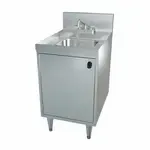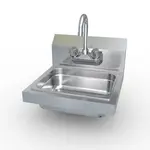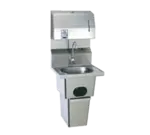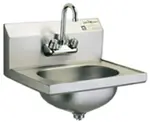
Where And When Must A Food Handler Wash Their Hands?
- Why Is It Important for Food Workers to Wash Their Hands?
- When Should Food Handlers Wash Their Hands?
- How to Wash Hands Correctly
- Where Is it Acceptable for Food Handlers to Wash Their Hands?
- Where Should Sinks Be Available for Food Service Workers?
- What Items Are Required at a Hand Wash Sink?
- To Wrap Up!
In the bustling world of food service establishments, ensuring proper hand hygiene is not just a simple chore; it is a critical responsibility that can make all the difference between safe, delicious meals and potential health hazards. Handwashing is a fundamental practice for food handlers, as it directly impacts food safety and the prevention of foodborne illnesses. In this comprehensive guide, we will delve into the importance of handwashing for food workers and explore the specific instances and methods for washing hands correctly to ensure the highest standards of hygiene.
Why Is It Important for Food Workers to Wash Their Hands?
Clean hands are the first line of defense against food contamination. In the food service industry, where various raw ingredients, surfaces, and utensils are handled regularly, the risk of transferring harmful pathogens is significant. Food handlers may inadvertently carry bacteria, viruses, and other contaminants on their hands, potentially leading to foodborne illnesses among customers. By washing their hands regularly and thoroughly, food workers can prevent the transmission of germs and bacteria, thereby safeguarding the health and well-being of both their customers and the reputation of their establishment.
When Should Food Handlers Wash Their Hands?

1. Before Food Handling
The adage "clean hands make safe food" couldn't be truer. The first step in any food preparation process should always involve handwashing. Before touching any food items, food handlers must thoroughly wash their hands with soap and water. This practice not only removes visible dirt but also eliminates any potential contaminants that may have been picked up from other surfaces. Ensuring clean hands before handling food sets the foundation for safe food preparation.
2. After Touching Contaminated Surfaces
Throughout a bustling day in the kitchen, food handlers are bound to come into contact with various contaminated surfaces. These may include trash bins, cleaning tools, or soiled utensils. Regardless of how clean a food handler's hands may appear, touching such surfaces can lead to the transfer of harmful microorganisms. To avoid cross-contamination and maintain food safety practices, food handlers must wash their hands immediately after touching contaminated surfaces.
3. After Handling Raw Food
Raw food, especially meat, poultry, and seafood, is a potential hotspot for dangerous pathogens such as Salmonella, E. coli, and Campylobacter. When food handlers come into contact with raw ingredients, there is a high risk of transferring these pathogens to ready-to-eat foods. So when must a food handler wash their hands? To prevent foodborne illnesses, food handlers must wash their hands diligently after handling raw food, especially before touching other ingredients or surfaces.
4. After Using the Restroom
Handwashing after using the restroom is a non-negotiable practice. Fecal-oral pathogens pose a significant threat, and proper handwashing after using the facilities prevents the transmission of these harmful microorganisms. It is not only a matter of personal hygiene but also a critical step in safeguarding public health.
5. After Sneezing, Coughing, or Touching the Face
In today's world, with the increased awareness of the spread of infectious diseases, the importance of handwashing after sneezing, coughing, or touching the face cannot be stressed enough. In the food service industry, where close contact with customers and food is inevitable, food handlers must wash their hands immediately after such actions. This practice minimizes the risk of contaminating surfaces or food with potential pathogens.
6. Handling Different Food Types
Cross-contamination can occur when pathogens from one food item transfer to another. To prevent this, food handlers should be vigilant when switching between handling different types of raw foods, such as vegetables and meats. Washing hands before handling a new food item ensures that any potential contaminants from the previous task are removed, mitigating the risk of cross-contamination.
7. Before Donning Gloves
Gloves are often used in food handling to provide an additional layer of protection against contamination. However, gloves are not a substitute for handwashing. Before putting on gloves, food workers must wash their hands to ensure that the gloves themselves remain uncontaminated. Failure to do so can render the gloves ineffective in preventing cross-contamination.
How to Wash Hands Correctly
Handwashing is a simple yet highly effective practice that requires attention to detail. To wash hands correctly, a food handler must first follow the proper handwashing procedure:
1. Wet your hands with clean, running water
Using warm water, wet your hands thoroughly, making sure the water covers all surfaces of your hands and wrists. The warmth of the water also helps to break down dirt and oil on the skin.
2. Apply soap and lather well, covering all surfaces of the hands
Dispense an adequate amount of soap onto your hands. Create a rich lather by rubbing your hands together, ensuring the soap covers all areas, including the back of your hands, between your fingers, and under your nails. Lathering for at least 20 seconds allows the soap to interact with and remove germs effectively.
3. Scrub your hands for at least 20 seconds
The duration of hand scrubbing is crucial for effective handwashing. Singing the "Happy Birthday" song twice or counting to 20 while scrubbing your hands ensures that you spend enough time cleaning all surfaces thoroughly.
4. Rinse your hands thoroughly under running water
Rinse your hands under clean, running water, allowing the soap and germs to wash away. Avoid using stagnant water or a basin, as it can harbor bacteria.
5. Dry your hands using a single-use paper towel or air dryer
Proper hand drying is essential to complete the handwashing process. Use a disposable paper towel or an efficient air dryer to dry your hands completely. Avoid using cloth towels, as they can become a breeding ground for bacteria.
Where Is it Acceptable for Food Handlers to Wash Their Hands?

Food safety is of paramount importance in any food-handling environment. To ensure the highest standards of hygiene and prevent foodborne illnesses, proper handwashing practices are essential for all food handlers. One important aspect that plays a significant role in maintaining food safety is the implementation of Hazard Analysis Critical Control Points (HACCP) certification.
A HACCP certification ensures that food service establishments follow a systematic approach to food safety that identifies, evaluates, and controls potential hazards throughout the food production and handling process. It is internationally recognized and helps food establishments maintain the highest standards of safety and quality. When it comes to handwashing practices, the HACCP certification outlines specific guidelines to ensure that food handlers maintain proper hygiene.
This leads to the next question: where can a food worker wash his/her hands? According to HACCP principles, designated handwashing stations should be readily available in specific areas where food handlers work. These stations should be conveniently located, easily accessible, and equipped with adequate supplies such as soap, water, and single-use towels. Food handlers should be trained on proper handwashing techniques, including the appropriate duration and use of soap to effectively eliminate harmful bacteria and contaminants.
To properly implement HACCP guidelines, all food handlers must also understand the distinctions between common food safety terms, such as food sanitation and food safety, disinfection, cleaning, sterilization, and more.
Where Should Sinks Be Available for Food Service Workers?

In food service establishments, the strategic placement of sinks is crucial to promote effective handwashing and maintain overall hygiene. Food safety regulations, including those governed by the HACCP certification, require that sinks be available in certain key areas to facilitate proper handwashing for food service workers. Here are some essential locations where sinks should be available for food service workers:
1. Food Preparation Areas
Sinks should be readily available within or in close proximity to food preparation areas. Food service workers frequently handle raw ingredients, process food items, and engage in various food preparation tasks. Placing sinks in these areas encourages food handlers to wash their hands regularly. This is especially important when switching between different food items to prevent cross-contamination.
2. Cooking stations and cooking lines
Cooking stations and cooking lines are where food is cooked, grilled, or otherwise prepared for serving. Sinks should be strategically placed near these areas to allow chefs and cooks to wash their hands promptly before and after handling cooked or partially cooked food. This helps prevent the transfer of harmful bacteria to the food during the final stages of preparation.
3. Service Areas
Sinks should be available near food serving counters to facilitate proper hand hygiene for employees involved in serving food to customers. As food is being plated and served, there is a risk of contamination if employees' hands are not properly washed between handling different food items or touching non-food surfaces. Handwashing is vital before handling clean items to prevent the introduction of contaminants, and after handling dirty items to avoid cross-contamination.
4. Employee restrooms
Proper handwashing facilities must be available in employee restrooms. This ensures that all staff members, including kitchen and food service workers, maintain personal hygiene after using the facilities. Regular handwashing in restrooms helps reduce the risk of contaminating food and food-contact surfaces.
What Items Are Required at a Hand Wash Sink?

A properly equipped hand wash sink is essential to ensure effective handwashing and maintain optimal hand hygiene in food service establishments. The presence of specific items at the hand wash sink encourages food handlers to follow proper handwashing protocols and prevents cross-contamination. Here are the key items that should be available at a hand wash sink:
1. Running Water
The most crucial item at a hand wash sink is a continuous supply of clean, running water. Running water is essential for rinsing away dirt, debris, and pathogens effectively. Furthermore, touchless running water allows food handlers to thoroughly clean their hands without having to touch potentially contaminated faucet handles, reducing the risk of re-contamination.
2. Soap
An antibacterial soap dispenser should be within easy reach of the hand wash sink. The soap dispenser should contain liquid or foam soap specifically designed for handwashing. Using soap is vital for breaking down oils, dirt, and microorganisms on the hands, making it easier for water to rinse them away.
3. Single-Use Towels or Air Dryers
Handwashing is not complete without proper hand drying. Disposable paper towels or an efficient air dryer should be provided near the hand wash sink. After washing their hands, food handlers should use a paper towel or an air dryer to dry their hands thoroughly. Drying hands removes any remaining moisture that may harbor bacteria and also helps prevent the transfer of germs to surfaces.
4. Waste Receptacle
A waste receptacle should be conveniently placed near the hand wash sink to allow food handlers to dispose of used paper towels properly. Having a waste bin nearby encourages food handlers to discard paper towels immediately after use, promoting cleanliness and preventing clutter around the hand wash area.
At the same time, it's crucial to reduce food waste, another critical aspect of food service operations. Minimizing food waste is not only an environmental responsibility but also a practical and economic concern for food establishments. Proper food waste management strategies can help reduce operational costs and contribute to a more sustainable future.
5. Handwashing Procedure Guide
Placing a step-by-step guide or poster illustrating the proper handwashing procedure can be helpful, especially for new employees or as a reminder for everyone. The guide should detail the steps for wetting hands, applying soap, scrubbing for at least 20 seconds, rinsing thoroughly, and drying hands completely.
To Wrap Up!
In the fast-paced and demanding food service industry, proper hand hygiene is not a mere suggestion; it is an absolute necessity. Handwashing is the foundation of food safety, protecting both customers and the reputation of the establishment. By understanding the critical moments when food handlers must wash their hands and diligently follow the proper handwashing procedure, the risk of foodborne illnesses can be significantly reduced.
By embracing a culture of effective hand hygiene and implementing comprehensive food safety practices, food service establishments can create a safe and hygienic environment for both their customers and staff. As responsible individuals in the food service community, let us remember that clean hands are not just a personal matter; they are the key to serving safe, wholesome meals to our valued customers.
By staying informed and implementing these essential practices, you can elevate food safety, minimize waste, and deliver exceptional dining experiences. Let us work together to create a food service industry that not only delights customers but also prioritizes their health and well-being. Together, we can build a stronger, safer, and more sustainable foodservice community.
FAQ
Should a food handler wash their hands every hour?
The frequency of handwashing should be dictated by the tasks performed and the establishment's food safety guidelines. While washing hands every hour may be unnecessary in some cases, food handlers should wash their hands whenever they switch between handling different food items, touching potentially contaminated surfaces, or performing tasks that may lead to hand contamination.
When should a food handler wash their hands twice?
Food handlers should wash their hands twice when switching between handling raw food and ready-to-eat food. This practice prevents cross-contamination and ensures the safety of the prepared meals. Additionally, washing hands before donning gloves is essential to maintain the integrity of the gloves and prevent cross-contamination between tasks.
How often do restaurants require you to wash your hands?
The frequency of handwashing in restaurants should align with established food safety regulations and guidelines. Typically, food handlers are required to wash their hands before starting work, after specific tasks such as handling raw food, touching their face, or using the restroom, and at regular intervals during their shifts.
What is the ‘Employees Must Wash Hands’ rule?
The ‘Employees Must Wash Hands’ sign is a common requirement in restrooms of food establishments. It serves as a reminder for food workers to wash their hands thoroughly after using the facilities, in compliance with food safety regulations. This sign reinforces the importance of handwashing for both employees and customers.
What is the best temperature for handwashing?
The water temperature for handwashing should be comfortable and warm, ideally around 100°F to 110°F (38°C to 43°C). Water that is too hot may cause skin damage, while water that is too cold might not effectively remove germs and bacteria. Warm water is more comfortable for prolonged handwashing and can help to loosen and remove dirt and oils from the skin more effectively.





